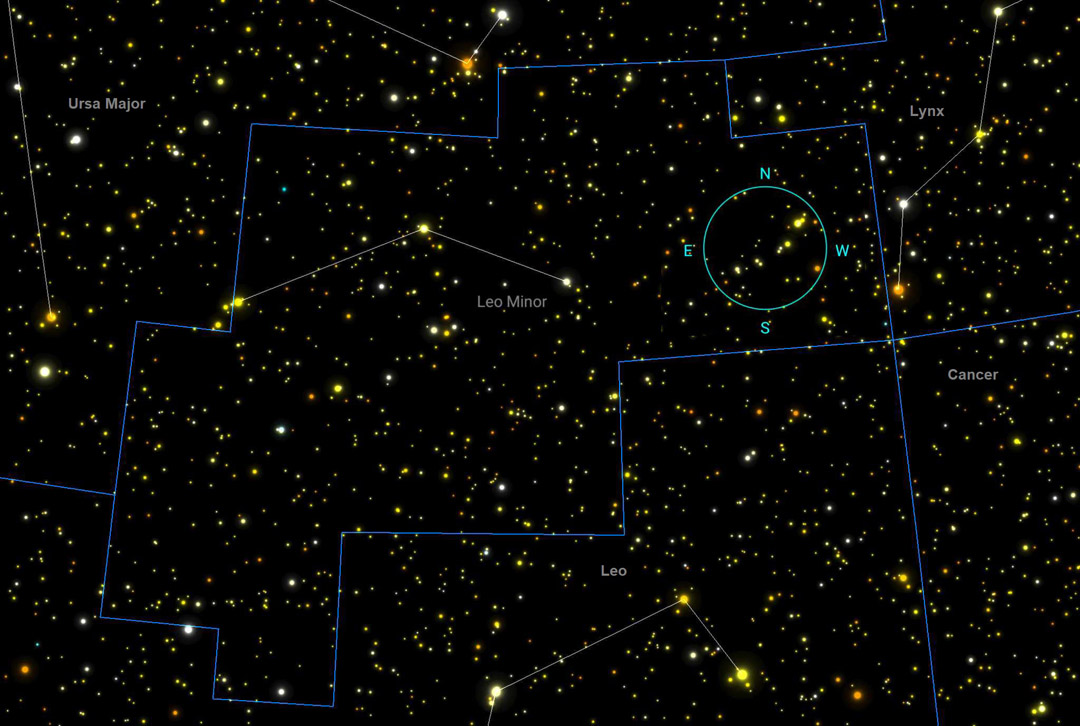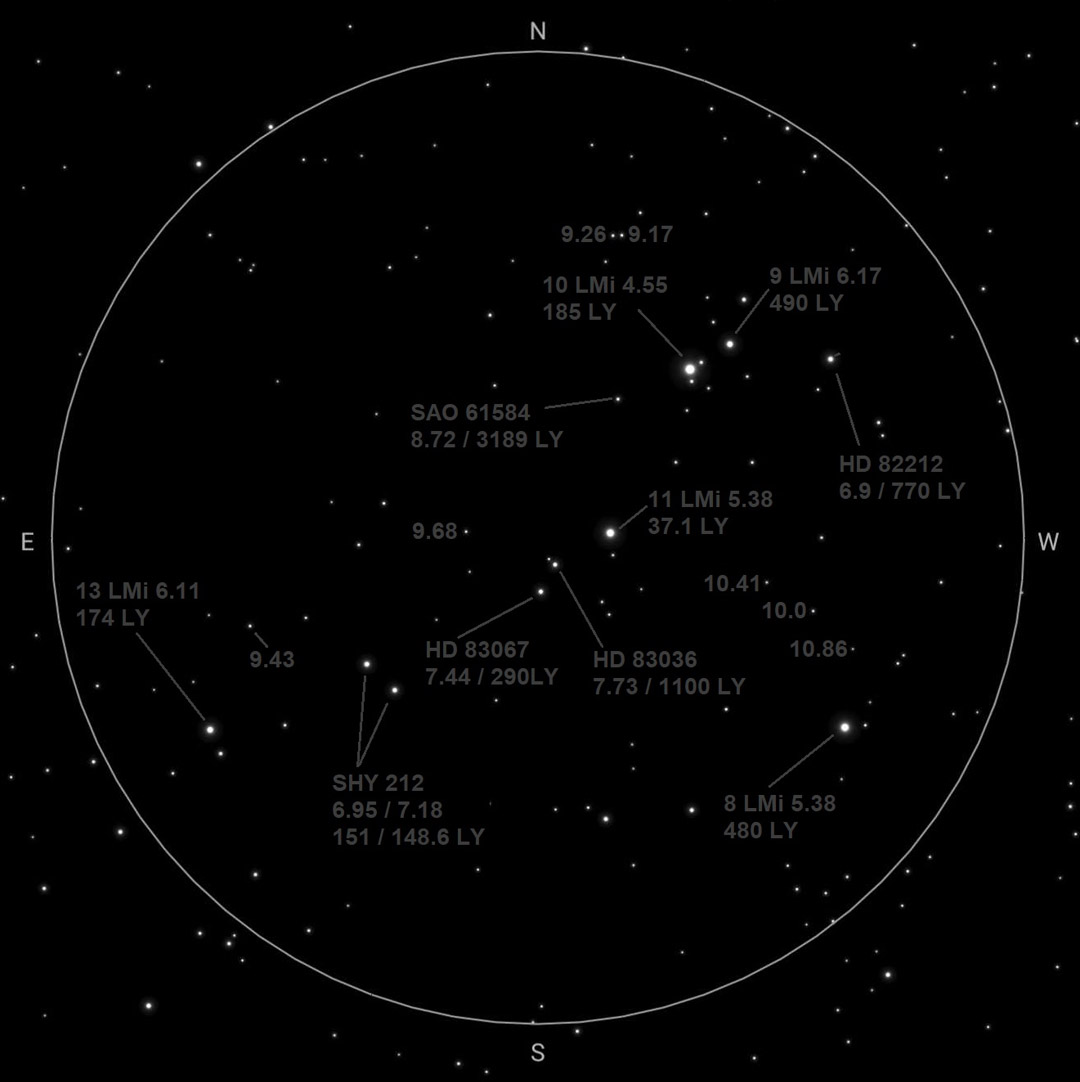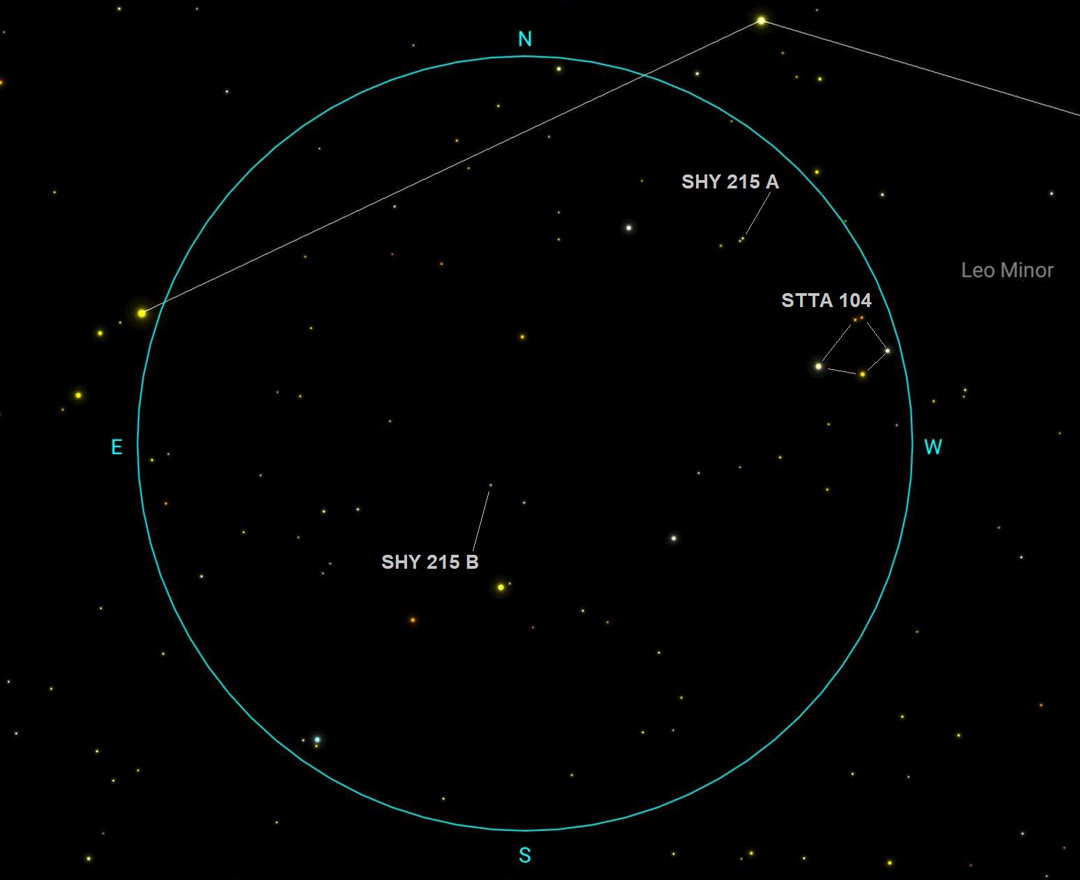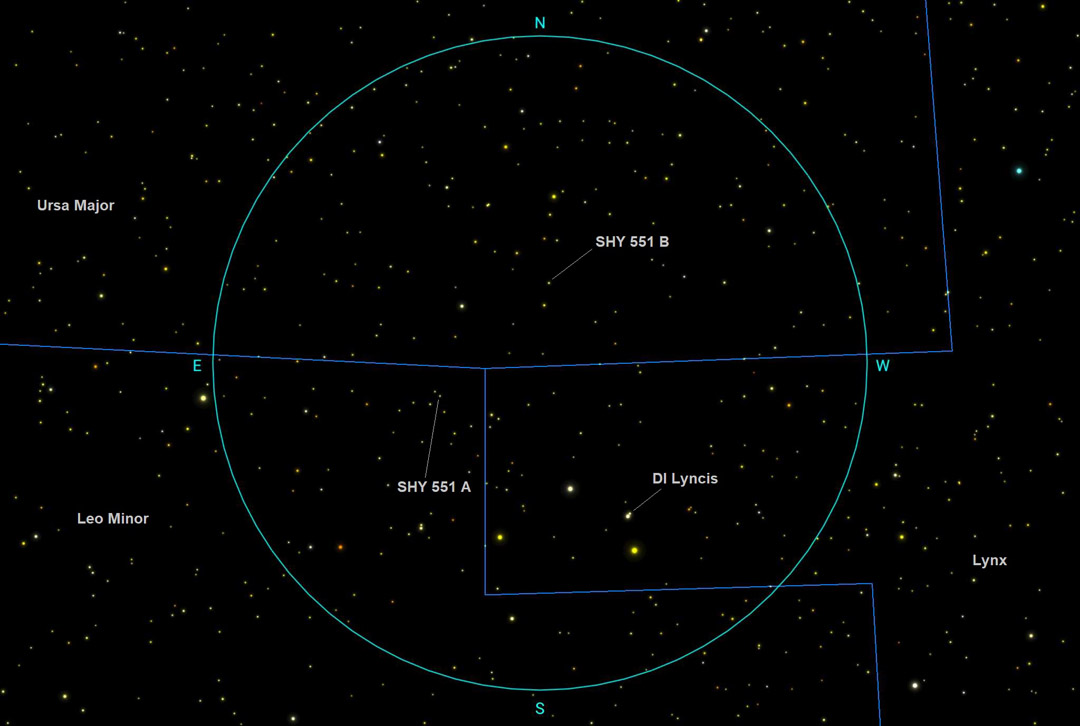Noting that Leo Minor contains four SHY binary stars, I decided to seek out the other three after observing SHY 552 in my first adventure with very wide binaries and other comoving stellar companions. 😉
SHY 552 has a relatively cozy separation of 106.9 arc-seconds. My next quarry would be SHY 212, with a separation of 494.5″, so a bit wider. (The double quote symbol means arc-seconds.) SHY 212 is shown above in a Sky Safari rendering with an Oberwerk 20×70 ED Ultra field ring (3.5 degrees) and stars to 10.5 magnitude. I haven’t checked the limits of the 20×70 from my suburban yard (Bortle 7 skies), but to get to 10.5 magnitude or below would certainly require a transparent night with no moon. And maybe a towel over my head for the ultimate shielding from intrusive light pollution from nearby driveways. 10.5 magnitude is easier to achieve with a 20x binocular from a darker site. Or with, say, an Oberwerk 100XL-SD binocular telescope. (Yes, that is a shameless Oberwerk plug. But they’re sponsoring my blog. Plus I own one, and it is awesome.)
Here is another Sky Safari chart showing the position of SHY 212 in relationship to the overall constellation, plus a few of its celestial neighbors.

I tried to compose a Digital Sky Survey image of the SHY 212 starfield using simbad, but it did not convey the beauty of the view with a 20x binocular, even in light polluted suburban skies. The double is positioned in a bright spray of stars, both intricate and charming. The starfield is just south of the striking DI Lyncis asterism, and just east of the 3rd magnitude stars 38 and 40 Lyncis, a white and orange duo visible naked eye from my yard. (Binoculars are required to enjoy the color contrast between the two stars.)
SHY 212 – HIP 47436 / 47403
09h40m +3520′
6.95/7.18 sep 494.5″ pa 228
Physical double star
Distance: 150.99 / 148.59 light years
Color Index: +0.50 yellow / +0.51 yellow
Spectrum: F5 / F5
Both stars show a slight tint of yellow to my eyes, viewed with the 20×70 EDU. Somehow the primary seems slightly more yellow, though according to the color index the secondary is the more yellow of the two. The difference is surely below the threshold of visibility. They are bright enough and wide enough to be observed with smaller binoculars, hand held. I can easily see it with a Nikon 7×42 EDG hand held.

Here is a further deep dive into the SHY 212 starfield. Some stars in the chart above are annotated with catalog numbers, magnitudes, and distances. Magnitudes only are listed for other stars to help establish the limiting magnitude in the field. The stellar data mostly comes from Sky Safari. A mounted binocular or binocular telescope is essential for this type of observation. If viewing from a light polluted site, a 20x or larger binocular is preferable.
The nearest star in the field is 11 LMI, at 37.1 light years. The most distant star I have identified is SAO 61584 just to the north, at a distance of 3,189 light years — nearly ten times father away.

SHY 215 – HIP 51312 / 52140
10h28m +34*53′
7.90/8.70 10,655.2″ (2*57’35.2″) pa 134*
Physical double star
Distance: 160.24 / 165.15 light years
Color Index: +0.64 yellow / +0.70 yellow
Spectrum: G0 / F8
With a separation of 10,655.2 arc-seconds (nearly 3 degrees), SHY 215 qualifies as a very wide binary indeed. 😁The widest I have knowingly observed. The A component appears to part of a multi-star system with the 8.53 magnitude star HD 90698, which is just under 120 arc-seconds away at a position angle of 132.5*. In reality, HD 90698 is at a distance of 380 light years. It’s twice as far as SHY 215 A. So only a line of sight coincidence. Its true companion takes some effort to locate.
The FOV indicator in the locator chart is 6.5 degrees — the typical field of 10×50 binoculars. This is a challenging observation to make with a 10×50 binocular in Bortle 7 skies, but doable with good viewing conditions. The double star STTA 104, with its distinctive asterism trio of LMi 30, 28, and 27 is a handy navigation aid.
The pleasure of making an observation like this for me is to know that these two seemingly unrelated stars are companions separated by only a few light years and moving through space together. It wasn’t possible to make such connections until dramatic advances in the amount and quality of stellar astrometric data were made by the European Space Agency’s Hipparcos and later Gaia space satellites. The paper by Ed Shaya and Rob Olling is based on the 2.5 million+ Tycho2 stellar catalog from the original Hipparcos mission in the early 1990s. The distances listed for the SHY double stars described in this post have been updated from the Gaia Early Data Release 3 catalog published in 2020.

SHY 551 – HIP 47851 / 47399
09h45m +41*09′
AD 9.90/8.82 sep 5,616.3″ (1*33’36.3″) pa 317*
Physical double star.
Distance: 237 / 235 light years
Color Index: +0.39 yellow-white / +0.56 yellow
Spectrum: F0 / F8V, main-sequence
The final SHY binary star in Leo Minor is the most challenging to observe from my yard because the primary is only 9.9 magnitude. That is getting close to the magnitude limit for 10×50 instruments on a transparent, “dark” night with the moon not present. The separation is about half that of SHY 215 — 5,616.3 arc-seconds. Still an astonishing separation. The chart above includes constellation boundaries for Ursa Major, Leo Minor, and Lynx. The DI Lyncis (STF 1369) asterism provies a helpful navigation reference. Also, STF 1369 is challenging for 10×50 binoculars but can be resolved with mounted instruments.
With patience I was able to pick out the faint arc of 9th magnitude stars just south of the SHY 551 A star. And once that was in view, the A component could also be steadily seen. I could occasionally glimpse the field star to the north east (TYC 2995-0642-1), which is listed in Sky Safari as 10.03 magnitude. The B stars is brighter (8.76 magnitude) and more easily seen. This observation is much easier to make with the 20×70 EDU. From observations a few nights previously, with somewhat hazy conditions, I wasn’t sure it would be possible to observe this pair with a 20x binocular from my yard. Sky transparency makes a critical difference. If you are not able to see them with 20x binoculars from a suburban location, and the sky is at all hazy, wait for a better night and try again. 😉
Leo Minor is an often disregarded constellation lacking popular deep sky objects, like the Messier list. But with some Sky Safari chart scanning and internet research, I found an intriguing set of objects that has provided many hours of enjoyable viewing. Plus somewhat challenging reading (for a lit major) that has increased my appreciation of recent advances in stellar astrometry. Not to mention the somewhat less demanding diversion of roaming Leo Minor’s constellation boundary and untangling it from the hind paws of the big bear.

